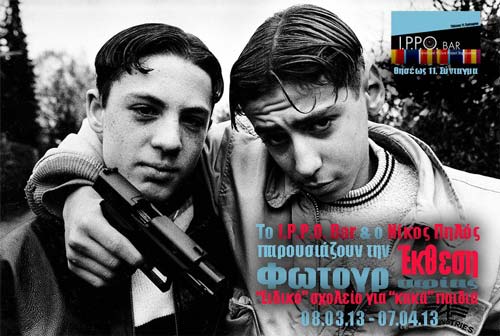«Ειδικό» σχολείο για «κακά» παιδιά

έκθεση φωτογραφίας του Νίκου Πηλού στο IPPO Bar
To IPPO Bar και ο Νίκος Πηλός παρουσιάζουν από Παρασκευή 08 Μαρτίου έως και Κυριακή 07 Απριλίου 2013 την έκθεση φωτογραφίας με τίτλο «Ειδικό» σχολείο για «κακά» παιδιά
«Ειδικό» σχολείο για «κακά» παιδιά - Αμβούργο, Γερμανία
«Ένα παιδί πάντα προσπαθεί να κεντρίσει την προσοχή. Ο τρόπος για να το πετύχει αυτό είναι μέσω της βίας, σωματικής ή προφορικής».
Καθηγητές στο σχολείο Astrid Lindgren
Το σχολείο Astrid Lindgren ιδρύθηκε το 1927 στο Αμβούργο, όντας το πρώτο σχολείο στη Γερμανία για παιδιά με αντικοινωνική συμπεριφορά. Τα παιδιά συνήθως προέρχονται από φτωχές και αμόρφωτες οικογένειες ενώ το 40% αυτών είναι μετανάστες δεύτερης γενιάς. Το portfolio αυτό προσπαθεί να απαθανατίσει τον τρόπο με τον οποίο τα παιδιά εκφράζουν εαυτούς χωρίς να ασκεί κριτική στη συπεριφορά τους.
Portfolio 6
“Special” schools for “bad” children
Hamburg, Germany
“Sonderschule” means special school, but “special” in this case is an euphemism. Astrid Lindgren Schule in Hamburg was founded in 1927 as the 1st special school of the kind. The students of the school are considered special not because they suffer some kind of disease, but because of their “antisocial” behaviour.
Immigrants’ children are (naturally) overepresented as they count for 40% of the school’s students. This mosaic of nationalities (Germans, Arabs, Yugoslavs, Spanish, Turkish, Greeks, even children from Thailand or Afghanistan) shows in what extent, even in a multicultural society, social origin can influence one’s fate.
These children share a similar past and a predictable future. They come from families with a poor educational and financial standard. Quite often, their parents are separated. Boys or girls, they have a record of minor juvenile delinquency or they have repeatedly been expelled from their previous schools. In their school life, they fail because of their lack of concentration and their “antisocial” behaviour. As one of their tutors put it: “A child always seeks to attract attention. Their way of doing it is violence, physical or verbal”.
This portfolio tries to capture their way of expressing themselves, their wits, their moods, through personal close ups, a sort of “visual interviews”. There is also a sequence of photos that show them interacting with each other: with friendship or rage, expressing anger or exasperation, forming volatile coalitions, usually according to the distinction between native German and immigrants.
In a few cases, they even seem proud to show themselves off on camera by cursing each other, faking an aggressive posture, or even unveiling a gun.

